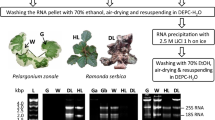Abstract
The Mexican marigold (Tagetes erecta) produces inflorescences of intense yellow color that contain high levels of xanthophylls, particularly lutein, which makes it a suitable model for the study of carotenoid biosynthesis and regulation throughout the development of the inflorescences. However, these studies require the recovery of total RNA from floral buds and inflorescences at different developmental stages, each of which presents specific extraction problems. Four protocols were tested, but only through the modification of one of them was it possible to obtain total RNA of sufficient quality and quantity to perform RT-PCR and Northern blots and to construct a cDNA library. This article presents the modified protocol for the recovery of total RNA from carotenoid-rich plant tissues.
Similar content being viewed by others
References
López-Gómez, R. and Gómez-Lim, M. A. (1992) A method for extracting intact RNA from fruits rich in polysaccharides using mango mesocarp. Hort. Sci. 27, 440–442.
Verwoerd, T. C., Dekker B. M. M., and Hoekeman A. (1989) A small-scale procedure for the rapid isolation of plant RNAs. Nucleic Acid Res. 17, 2362.
Shellie, K. C., Meyer, R. D. and Mirkov, T. E. (1997). Extraction of total RNA from melon mesocarp tissue. Hort Sci. 32, 134.
Schuler, M. A. and Zielinski, R. E. (1989) Methods in Plant Molecular Biology Academic Press Inc., San Diego, CA.
Logemann, J., Schell, J., and Willmitzer, L. (1987) Improved method for the isolation of RNA from plant tissues. Anal. Biochem. 163, 16–20.
Chomczynski, P. and Sacchi, N. (1987) Single-step method of RNA Isolation by acid guanidinium thiocyanate-phenol-chloroform extraction. Anal. Biochem. 162, 156–159.
Sambrook, J., Fritsch, E. F. and Maniatis, T. (1989) Molecular cloning: A laboratory manual. Cold Spring Harbor Laboratory Press, New York.
Predigen, E. (1998) RNA Isolation. Ambion Technotes. 5, 1–10.
Jones, C. S., Iannetta, P. P. M., Woodhead, M., Davies, H. V., McNicol, R. J., and Taylor, M. A. (1997). The isolation of RNA from raspberry (Rubus idaeus) fruit. Mol. Biotechnol. 8, 219–221.
Sul, I. W. and Korban, S. S. (1996). A highly efficient method for isolating genomic DNA from plant tissues. Plant tissue culture and biotechnol. 2, 113–116.
Weber, K., Bolander, M. E. and Sakar, G. (1998). PIG-B: A homemade monophasic cocktail for the extraction of RNA. Mol. Biotechnol. 9, 73–77.
Author information
Authors and Affiliations
Corresponding author
Rights and permissions
About this article
Cite this article
Chi-Manzanero, B., Robert, M.L. & Rivera-Madrid, R. Extraction of total RNA from a high pigment content plant. Mol Biotechnol 16, 17–21 (2000). https://doi.org/10.1385/MB:16:1:17
Issue Date:
DOI: https://doi.org/10.1385/MB:16:1:17




